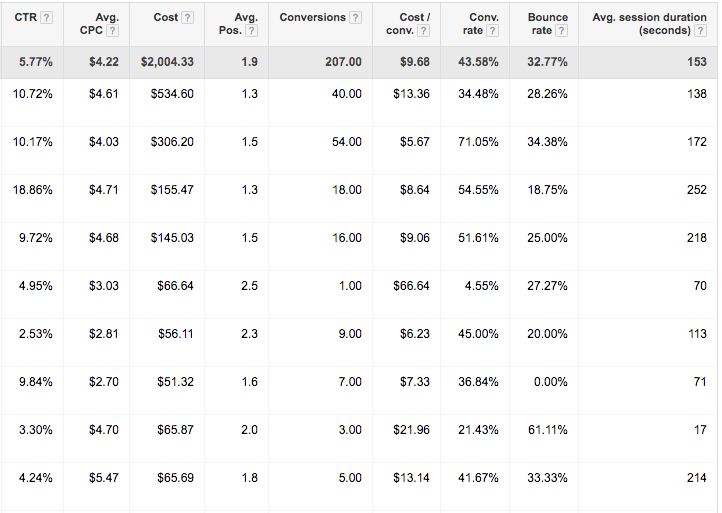
Having worked with over 200 accounts and having over 20 years of combined paid search experience, the experts at Aronson Advertising have identified several key metrics that successful auto dealerships have in common.
The metrics below are the Top 5 AdWords KPIs that are vital in measuring paid search success at Aronson. These KPIs can help you judge the effectiveness of your own paid search campaigns.
1. Cost Per Lead
Cost per Lead is a great measurement of how much, on average, it costs you to obtain a phone call, an interaction, or a form submission for a client. The majority of clients judge the success of a campaign by this number – if this is the one metric that performs, your campaign is viewed as a success.
Cost per lead is also a metric that can help you balance your channel portfolio. If it costs $50 to attain a lead using Instagram and it costs $20 to do the same using Google AdWords, it’s clear which campaigns should receive the majority of your ad spend.
Tip: to get the most out of your account, rate your most important conversions by importance and add a small corresponding monetary value to each of the conversions. Then use “All Conversion Value / Cost” column within AdWords to assess effectiveness of your keywords, ads, and campaigns.
2. Number of Leads
Evaluate your lead types. Form submissions occur less often because mobile users prefer to call businesses. A number of sourcesi,ii show that only about 1% of a site’s visitors will submit a form, while phone calls have shown huge growth as a metric in recent years. This trend is very much correlated with the considerable portion of the internet’s population moving to mobile devices. We are seeing the exact same trend with our client websites. “Get a quote” and contact forms are quickly becoming a relic in the digital space as they have a longer response time, take longer to fill out, and don’t always let you ask all of your questions like a phone call would. With a phone call, the customers can get a quote or schedule an appointment immediately as opposed to waiting for a response from a filled out form.
Tip: To get the most out of your best-performing leads place your best Call to Action on all the product pages, inventory pages, and even on the Contact pages.
3. Cost per Click (CPC)
Cost Per Click acts as a KPI that helps you distinguish which of your campaigns are cost-effective while helping you assess your ROI. A low CPC is often considered a good thing, though this doesn’t always mean that your campaign is successful. General keywords (short, broad match queries like “new car”) can bring in a great number of clicks from a whole variety of search queries, but they may bring in visitors with little to no purchase intent who are more likely to leave your site after browsing a few pages. Thus, clicks that may be higher in price but are known to bring in key conversions are more likely to have a much larger return on your investment. Keep in mind that more expensive isn’t always better. Find the middle ground: make sure that your campaign utilizes the cheapest possible clicks that bring in the highest numbers of leads.
Tip: You can learn more about purchase intent and how to make your campaigns more relevant in our recent article about Purchase Intent in Paid Search.
4. Impression Share
Impression share can help you see where your account stands compared to your competition. No matter the industry, it’s important to see what your competitors are doing, how much they are spending, and how competitive your market really is. This helps assess your company’s market share and enables you to go after the channels and competitors in a more refined way. Once your targeting is fine-tuned and the right keywords are in place, impression share shows if you are capturing all the possible leads with your campaigns or not.
Tip: You can actually see websites you are competing against and what their average ad position is within Auction Insights. Simply go to your campaign view, click on the details button and press All.
5. Engagement Metrics
Bounce rates and time spent on site are great user engagement metrics that you always want to keep an eye on. With high-ticket products such as cars, customers almost never buy online. In this case, user engagement metrics are a good gauge of how much your clients are engaging with your content, which pages perform the best, and which keywords bring in the clicks that show the highest level of interest in your products.
Tip: Keep in mind that mobile devices are going to show higher bounce rates and less time spent on site due to the very nature of mobile browsing. It’s much more convenient to do research in the comfort of your home on a bigger screen, so phones are often used as a means to finding a single piece of information.
Bonus: Store Visits
The Store Visit conversion is a new metric recently rolled out by Google and Facebook. By tracking customer interactions with your ads and website, Google can show the number of customers who have visited the store after clicking on your ads. This is a clear indicator that shows the real impact the ads are having on your customers and how much foot traffic they bring to your business.
What About Conversion and Click-Through Rates?
You might be wondering why we didn’t include conversion rates and CTR. Conversion rate can be a great KPI, but it depends on what sort of conversion goals your company has implemented. For example, some companies implement “soft” conversion goals that are met when a customer spends 4+ minutes on site. The “hard” conversions are usually calls from the site and form submissions. Thus the conversion rate is often misleading in the number of actual leads coming in.
Click-Through Rate may be interpreted in different ways. A high CTR means that you have found great keywords and ads that show promise. However, CTR is not a direct indication that you are driving leads.
Consider this scenario: you create an ad for a 2018 Chevy Corvette per your client’s request and you see some terrific CTR numbers. On a closer look, you start to notice that while the ad has received a great number of clicks, none of the visitors have called the dealership or have shown any meaningful conversions. In this case, the visitors are more interested in photos of new Chevrolet Corvettes, rather than purchasing one, so in this case the CTR becomes a secondary metric.
Final Words
Evaluating your campaigns can be overwhelming. It’s important to find the right balance of bringing in high purchase intent visitors, saving on campaign costs, and maximizing the number of leads you receive from each campaign. So keep these top KPI’s in mind, decide which formula works for your product, and you will start seeing results.
How are you evaluating your performance? What are your go-to metrics? Let us know in the comments below!
___________________________________________________________________
[i]
Jonathan Cherki, 2 Ways to Create a Great User Experience for Your Website Visitors, Dealer Marketing Magazine, http://www.dealermarketing.com/2-ways-to-create-a-great-user-experience-for-your-website-visitors/. August 4, 2017
[ii]
Brian F. Pasch, Swimming With Digital Sharks: A Complete Guide for Automotive Managers to Succeed in a Digital Age. Chapter: Website Conversion Bookmarks. Digital: Bookbaby, 2016.


